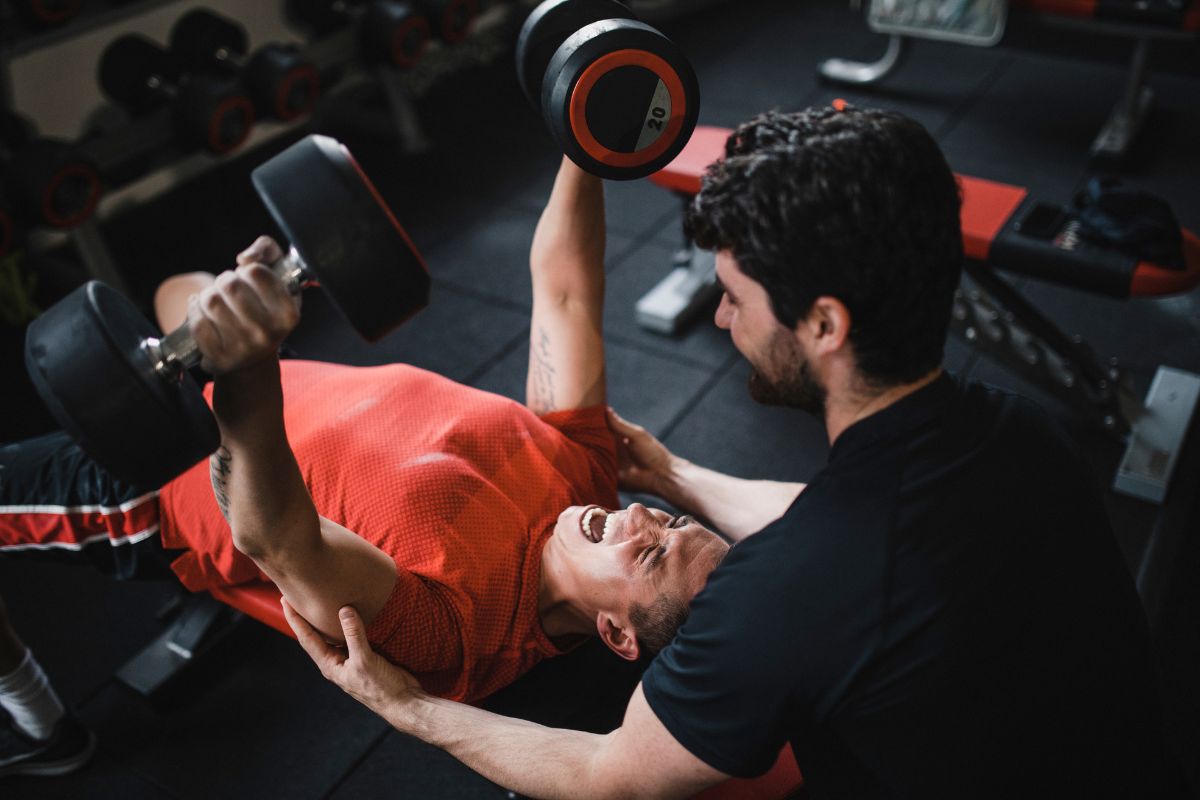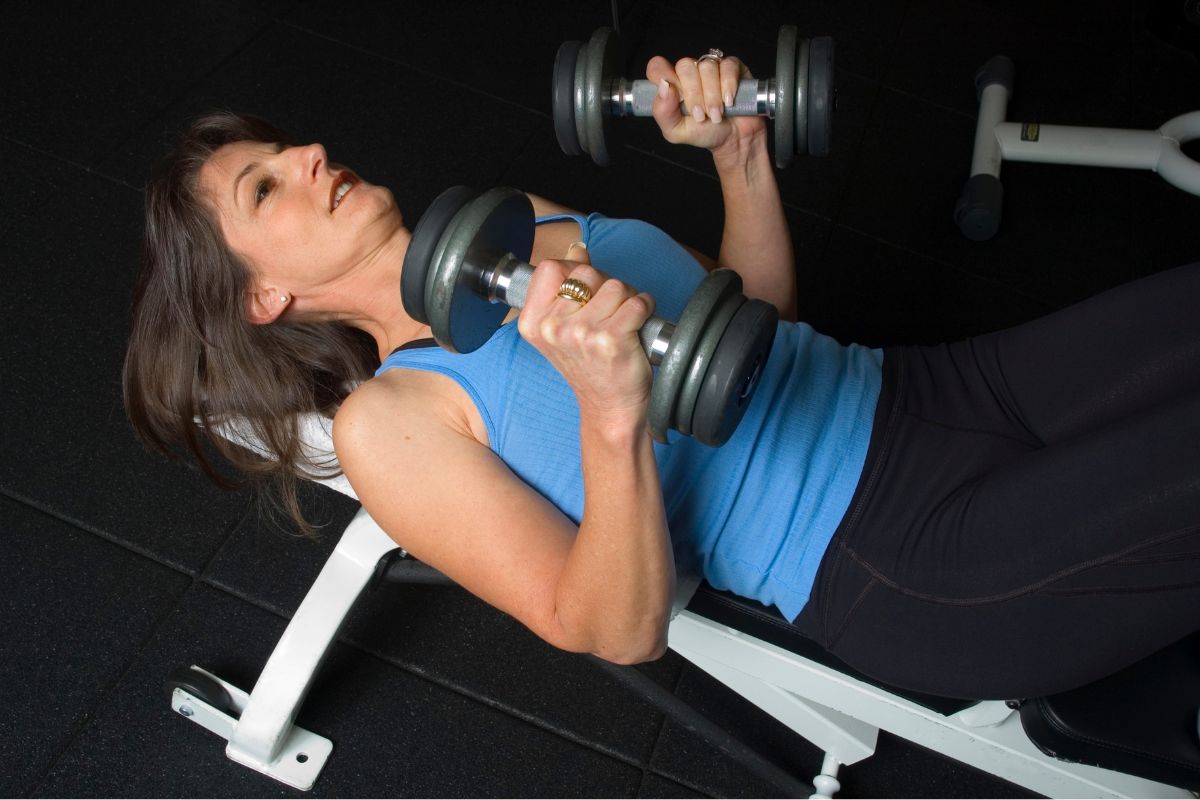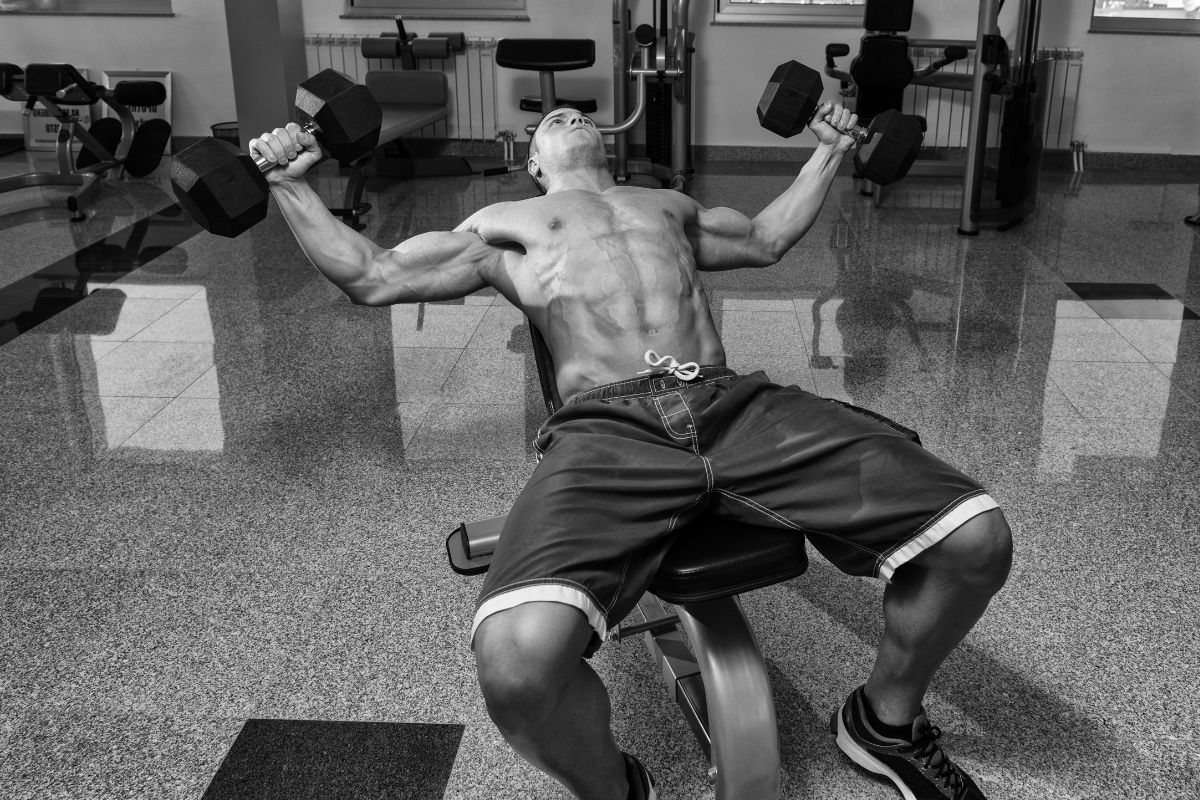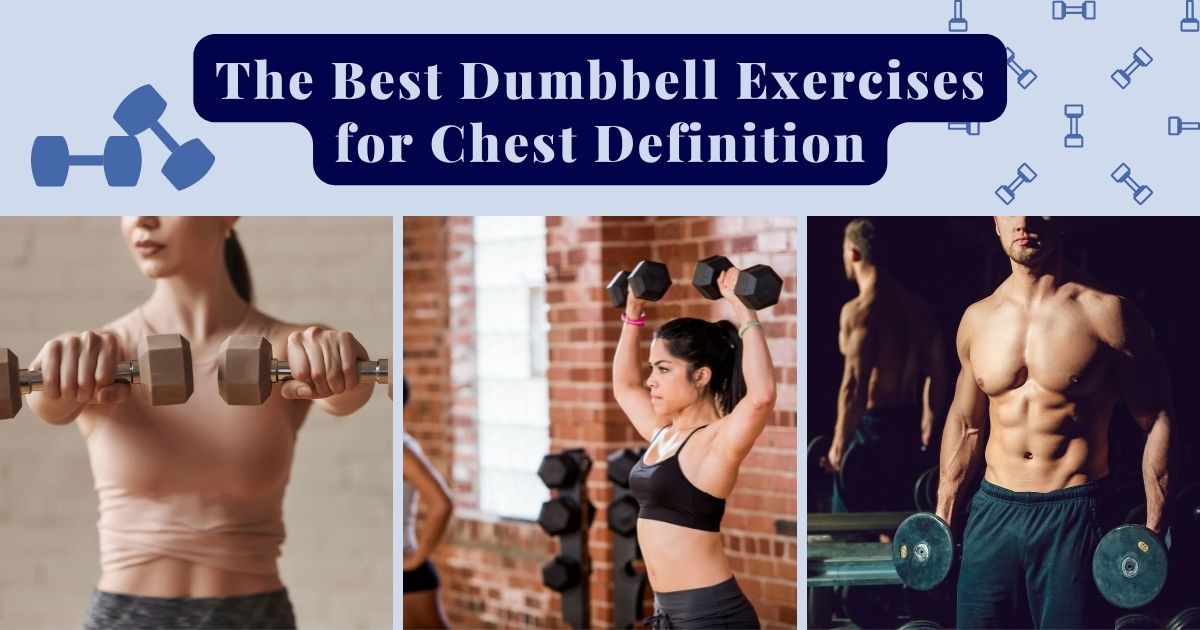The Ideal Chess Workouts With Dumbbells
The best dumbbell exercises for the chest are an absolute must if you want to develop a large, muscular, clearly defined chest. It’s not that I have anything against barbell lifts—they have their place—but when it comes to hypertrophy and shaping the chest, dumbbell exercises are far superior to those performed with barbells.
You will understand why dumbbells are so beneficial for chest workouts and the five finest chest exercises you can do with dumbbells.

A List of Chess Workouts With Dumbbells
The following are the top five chest exercises with dumbbells.
Dumbbell Bench Press
It is generally agreed that the dumbbell bench press is the free-weight exercise that contributes significantly to developing clearly defined pecs. Because you may bring the dumbbells together at the height of the movement, this exercise gives you the opportunity for a more effective muscular contraction.
Compared to the barbell bench press, these exercises enable a greater range of motion, which benefits individuals with short arms and broad rib cages.
- Starting position: While lying face down on a flat bench, bring the dumbbells above your head. Maintaining a pronated grip on the dumbbells, twist your wrist so that your thumbs point in opposite directions.
- Place your arms so that they are parallel to your shoulders, with your elbows bent just a little bit. Then, slowly drop your arms and spread your elbows as far as possible.
- Hold for a second, and then using your chest, bring both arms up to meet in the center of your body in a triangle-like motion. At the top, make sure the dumbbells don’t contact one other.
- Tilt your wrists outwards so your thumbs point slightly upwards to achieve a greater muscle contraction. You should feel this in your forearms. Pull your chest toward your spine and hold the contraction for one to two seconds.
Sets: 3 to 5 sets
Repetitions: 12, 10, 8, 6 (pyramid sets)
Twisting Dumbbell Bench Press
This is the least popular among chest workouts with dumbbells, but it uses the non-fixed grip advantage that dumbbells offer.
The dumbbell rotation through 180 degrees at various points throughout the action stimulates all muscle fiber bundles that make up the pectoralis major. When you twist the dumbbells, it slows you down and forces you to utilize less weight than when you press them normally.
As a consequence of this, you shouldn’t place an excessive amount of importance on beating your personal best in this movement. Instead, put your attention on isolating and perfecting each muscle.
- Starting position: Pull the dumbbell above your chest while lying on a flat bench. Supinate your grasp on the dumbbells so that your pinkies face each other. This will allow you to twist your wrist more easily.
- Put your arms parallel to your shoulders and bend your elbows slightly. You can force a more powerful contraction by contracting your chest and pressing the dumbbells against each other simultaneously.
- As you slowly separate the dumbbells from each other while maintaining a contracted chest, lower your arms and spread your elbows apart in the same manner as you would during a standard dumbbell bench press.
- Slowly rotate your wrists so that your thumbs face one another once you lower the dumbbells to the bottom of the action. This is a pronated grasp.
- Hold the stretch for one second. At the peak, rotate your wrists to a supinated grasp by leveraging your chest to raise your arms.
- Squeeze your chest and press the dumbbells together, holding the contraction for one to two seconds. Repeat steps I through III, keeping the stretch for two seconds.
Sets: 3 sets
Repetitions: 12 to 15 reps
Crush Grip Dumbbell Bench Press
As the name suggests, you will feel like your chest is crushing. The motion consists of nothing more than pressing both dumbbells against each other throughout the entirety of the movement.
Your chest needs to be able to handle force applied in both a horizontal direction (using a “crush hold” on dumbbells) and a vertical direction (pressing dumbbells.) Because of this, the muscle can contract and activate extraordinarily.
- Starting position: Position yourself so that you are lying on a flat bench and raise the dumbbells so that they are over your chest. Bring the dumbbells together while maintaining the neutral grip with your palms facing each other and holding them in this position.
- Ensure your arms are parallel to your shoulders, and bend your elbows slightly. Put as much force as possible into pressing the dumbbells into each other while contracting your chest.
- While keeping the “crush-grip” on the dumbbells, bring them down to your chest until they are approximately 1 inch (2.5 centimeters) away.
- After finishing the chest exercise, lower the dumbbells to their starting positions and hold the contracted chest position for one second.
Sets: 3 to 4 sets
Repetitions: 15 reps
Dumbbell Flyes
You cannot consider a chest training program complete without performing this exercise. For a good reason, dumbbell flies are the most effective exercises a person might add to their chest workout routine to maximize their results. However, this technique makes it possible to perform a strenuous loading stretch.
The dumbbell flye is an excellent move to perform at the end of a dumbbell chest workout if done correctly. However, the most common and significant error that trainers make is pulling the dumbbells together too closely, which results in the loss of muscular contraction from a purely technical standpoint.
- Starting position: Position yourself so that you are lying on a bench and raise the dumbbells so that they are over your chest. Check to see that both of your palms are pointing in the same general direction.
- Adjust your arms to align with your shoulders, and bend your elbows slightly. You should bring your arms down in a broad arc until you feel a stretch in your chest. Minor discomfort is okay for this exercise, but agony is not.
- As you become more flexible, the range of motion that is safe for you to perform will expand; nevertheless, forcing it will result in injury.
- The bend in your elbows should remain continuous, and your arms should remain rigid as you hold the stretch for one second and then raise your arms in a wide arc with your chest. (Only your shoulders should move)
- Because doing so will result in a lack of chest contraction, the tops of the dumbbells should not touch one another. Contract your chest as tightly as you can for one second (imagine bringing your arms together with your pecs.)
Sets: 3 sets
Repetitions: 12 reps
Dumbbell Pull-Overs
Although they work the chest and the back simultaneously, dumbbell pullovers are more usually a back workout than a chest exercise. The range of motion and the bend in your arms are crucial in determining whether it will stimulate the anterior or posterior deltoid muscle groups.
This exercise is similar to dumbbell flies in that it allows for an intense weighted stretch. On the other hand, it targets the pectoralis major from a different angle. Thus it complements the fly exercise quite well.
- Starting position: Position yourself in the starting position by placing an upright dumbbell that you are holding with both hands on top of a bench and slightly off the edge of the bench.
- Lay across the bench on your back, ensuring that the only part of your body that makes contact with the surface is your shoulder blades. Ensure your neck is not resting on the bench to avoid injuring your cervical spine.
- Put both of your feet firmly on the ground, lower your hips, and while holding the dumbbell in both hands with your palms pressed to the inner side of the weight plates, perform the following exercise.
- To ensure that you have a secure hold on the dumbbell, wrap your thumbs around the grip and your fingers around the edge of the weight.
- Raise the dumbbell over your head, bend your elbows just a little bit (if you bend them too much, you’ll be working your back more than your chest), and then flex your chest for a split second.
- After lowering the dumbbell behind your head in a controlled manner until your arms align with your body, pause for a second to maintain the stretched position, and then raise the dumbbell so that it is above your eyes.
- Raise the dumbbell to the point where it is just above your forehead and squeeze your chest while holding the contraction for one second. Your back will feel the increased strain as a result of this.
Sets: 3 sets
Repetitions: 12 reps

The Analogy of Chest Muscles
Pectoralis major and pectoralis minor are the muscles found on either side of your chest and make up your chest. We refer to them as the pecs when we consider them collectively.
The Pectoral Major Muscle
The pec major is the larger of the two pec muscles and covers most of the chest. It has the name “major” because of its size. The sternocostal and clavicular heads are the two parts that make up the big fan-shaped muscle.
Your sternum is the origin of the sternocostal head, which is responsible for eighty percent of the pec major muscle’s overall size. In common parlance, this region is the “lower chest.” The primary function of this muscle is to bring your arm closer to your chest and across it.
The clavicle is the point of origin for the clavicular head (collar bone). This region is the “upper chest.” Its primary function is to assist in flexing the humerus. The overall action of the pec major is to drag the shoulder blades forward and down, adduct, and medially rotate the upper arm.
Therefore, to engage the pectoralis major muscle, you need to perform any activity that includes lifting the arm, reaching or pressing forward, or moving your arms across your body. Pec exercises are very important for your muscles.
The Pectoral Minor Muscle
The pec minor is a smaller, triangular muscle that sits beneath the pec major and attaches to your ribs and collarbone (a small hook-like profusion at the top of your shoulder blade). Even though the pec minor is on the front of your body, it exerts influence over the structures found in the back because it attaches to the shoulder blade.
The primary purpose of it is to stabilize the scapula by pulling it down, spreading it apart, and holding it in place, which ultimately gives your shoulders more support.
Serratus Anterior
The serratus anterior, also known as the boxer’s muscle, is a large serrated muscle that attaches to the sides of your shoulder blades and wraps around the outside of your ribs. It is also known as the boxer’s muscle.
Although the serratus anterior is not technically a component of your chest, it is an important contributor to the development of your pecs. This is because it is responsible for drawing the shoulder blades forward and upward during pec workouts.
The purpose of this explanation of the anatomy and functioning of these muscles in the chest is to assist you in better comprehending the necessity of performing a wide variety of workouts to achieve the complete growth of your chest. The degree to which these muscles are under stimulation will vary depending on your movements and the location of your body and arms.
Benefits of Dumbbells for Chest
Because they let you raise the maximum potential weight, barbells are excellent for working the chest. On the other hand, dumbbells offer far more flexibility. Dumbbells are undoubtedly the best equipment to train your chest, and the following benefits explain why this is the case.
Dumbbells Allow for a Greater Range of Motion
When you use barbells, the bar will come close to touching your chest before your pectoral muscles complete their full range of motion. You can activate the most number of muscle fibers feasible with dumbbells since they allow you to drop past your chest, which stretches your pecs to their fullest potential.
When working out with dumbbells, it’s important to be able to optimize the range of motion because it not only helps with stretching tension but also with contraction tension. This is because your arms are free to move in all directions, not only front to back and top to bottom.
In addition, while you are doing press-ups, you need to make an effort to keep the dumbbells from moving apart. This is not a viable option when performing a push on a straight bar. When you contract your chest, the motion of stabilizing the dumbbells and maintaining them in position will provide the highest amount of tension possible.
Note that the more you press forward, you will activate the more your serratus anterior. This is one of the reasons why dumbbells are generally superior for building the serratus anterior as well.
Balanced Growth and Strength
Whether or not you are aware, you have a stronger side that will compensate for the weaker side by slightly taking over the movement when you perform barbell presses. This occurs whether or not you are aware of it. It should be no surprise that you cannot accomplish this using dumbbell because each face has its weight.
You will be able to tell right away if your vulnerable side is falling behind. This indicates that you won’t be able to continue a set beyond the point where your weak side can tolerate it.
It also guarantees that your form stays on point by preventing it from getting all goofy, with your stronger side powering most of the movement (like when someone pushes up a barbell with one side higher than the other and doesn’t even recognize it). You will correct the imbalance in strength and muscle at some point.
In addition, if you feel that the weaker side of your body needs a little more effort on a particular set, you may always perform a few extra repetitions on that side.
Easier on the Joints
Because of their greater versatility, dumbbells allow you to use your arms in a manner that is easier on your joints as you work out. You can rotate your wrists and move your elbows and shoulders through a path that is comfortable for you to do so while you turn your wrists.
Ultimately, this enables you to shift stress away from your joints and onto your muscles instead (where they belong).
Strengthens Stabilizer Muscles Better
Stability is more important when doing this exercise because you use different weights for each hand. Not only does this activate your primary movers in another way, but it also works the small stabilizer muscles surrounding your joints, such as your rotator cuff muscles, pec minor, serratus anterior, and rhomboids.
Rhomboids are also one of the primary movers that get active this way. Shoulder and scapula complexes that are stronger and more resilient will be the end consequence of this process.
One might easily argue that dumbbells are the superior training tool for the chest. This does not imply that barbells, machines, or bodyweight exercises do not have their place in chest workouts; they most certainly do. However, we are saying that we are not arguing that they do not have their place.
Picking Up Dumbbells Safely
In addition to discussing the repercussions of excessive training injuries, it is vital to recognize safety issues, particularly when lifting large dumbbells by yourself. When working your chest with heavy dumbbells, you should feel completely at ease moving them into the beginning position and placing them back down on your own.
Lifting large dumbbells safely and effectively for chest exercises is possible if you have the right technique. You won’t put yourself at risk of getting hurt in the process. How exactly would you go about lifting these dumbbells?
- While seated on a bench, grab a certain pair of dumbbells in the desired weight range. Put the dumbbells on your thighs so that you may work out. Check that your hold is solid and that your hands face each other.
- As you lie back on the bench, push up your thighs to lift the dumbbells.
- Place the dumbbells on your chest while maintaining a straight arm position and placing your feet firmly on the ground.
- Your upper back, buttocks, and chest should be in contact with the bench. You should push the chest up (focus), pull the shoulders back (retract), and you should retract the shoulders.
- When you complete all your sets, put the dumbbells down and go back through the previous stages in reverse order.

Recap
Whenever you do your chest exercises at home, target your chest muscles anywhere from once to three times per week, depending on your needs. You can do the back and chest workout with dumbbells in this article. In that case, we guarantee that you will develop an attractive and powerful chest, regardless of whether your chest genetics are favorable or unfavorable.

